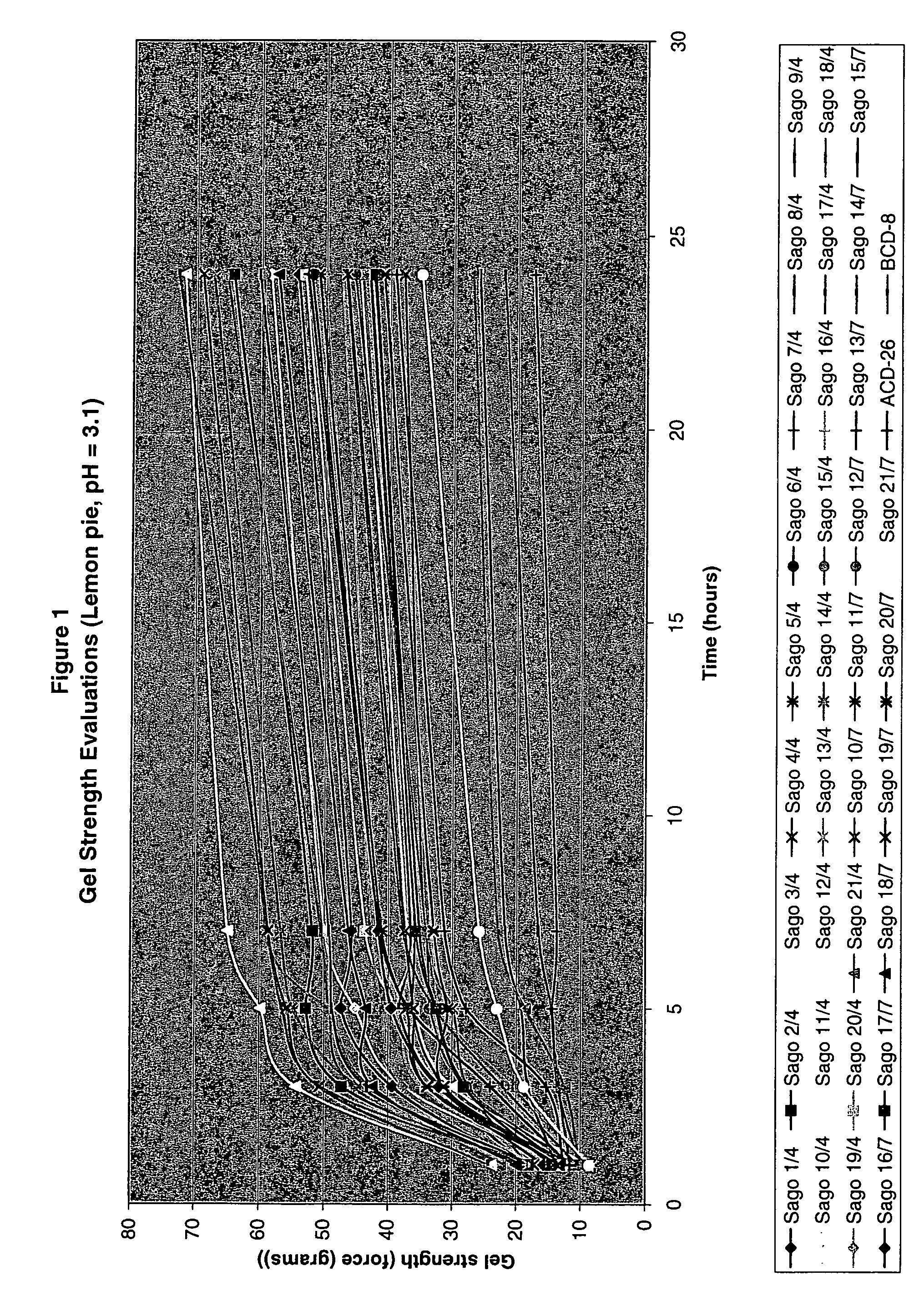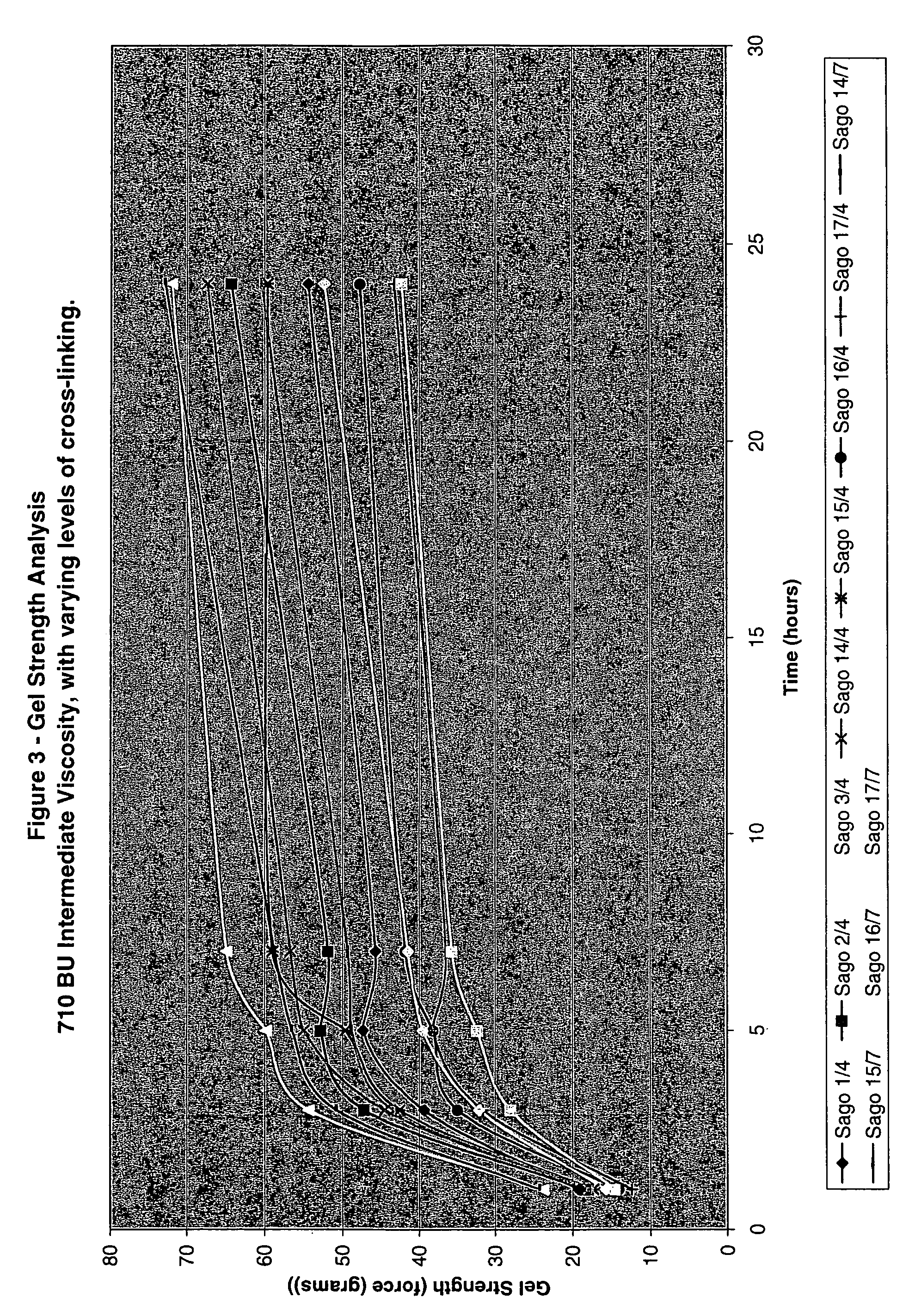Sago-based gelling starches
a technology of sago and starch, which is applied in the field of modified starch, can solve the problems of not being able to cut as cleanly with a spoon, not being able to operate with salt agents at low ph or in non-dairy based food systems, and achieves the effects of high gel strength, fast gelling, and smooth texture in both appearance and mouthfeel
- Summary
- Abstract
- Description
- Claims
- Application Information
AI Technical Summary
Benefits of technology
Problems solved by technology
Method used
Image
Examples
example i
[0075]This example illustrates a procedure for bleaching and converting sago starch to a required Brabender viscosity, then crosslinking the starch with phosphorus oxychloride.
[0076]A slurry was prepared by suspending 2000 g of sago starch in 3000 ml of tap water. The temperature of this slurry was adjusted to 45° C. in a hot water bath. Hydrochloric acid was used to adjust the pH to 2.5 and 5 g of sodium chlorite was added. After holding for two hours, the pH of the slurry was adjusted to 4.0. Sufficient sodium metabisulfite was added to neutralize any remaining oxidant.
[0077]The temperature was allowed to drop to 42° C. The alkalinity was then raised to between 28 and 32 ml 0.1IN HCl (50-ml sample) by slowly adding a 3% aqueous NaOH solution. To this mixture, 5.0 g of a 2% aqueous solution of potassium permanganate was added (i.e., 0.005% based on weight of starch, corresponding to 17.5 ppm of manganese ions based on the weight of starch). 2.0 g of 30% H2O2 is then added to the st...
example ii
[0079]This example illustrates a method of preparation of a variety of bleached, converted sago starches (all bleached in the manner of Example 1) having a wide range of viscosities as well as being crosslinked with a wide range of POCl3 treatment levels. As further examples will show, the Brabender of the optimum crosslinked sago base (prior to pregelatinization) will have a 95° C.+20 viscosity of 500 BU or higher and a BVD (‘Brabender Viscosity Differential’) of less than 5.
[0080]
TABLE 1SAGOINTERMEDIATE PEAKSAMPLE%%VISCOSITYBRABENDER VISCOSITY ANALYSISNo.H2O2*POCl3Viscosity (BU)Peak80° C.95° C.95° C. + 20′BVD10.10.0107101000980780700−20.40820.10.015710950940790700−15.95730.10.020710930925800720−13.51440.20.010550605585430345−26.49650.20.015550590575450375−21.73960.20.020550435430380350−11.62770.30.010430450440300225−31.8280.30.015430470460340265−26.08790.30.020430420420340290−19.048100.070.0258256256056256453.306110.070.03082539034039044014.706120.070.03582536030536041018.033130.0...
example iii
[0082]This example illustrates a method of pregelatinization by drum drying the above converted and crosslinked sago starches to obtain the instant gelling starches herein.
[0083]Each sample was drum-dried by slurrying 200 g starch in 300 ml water, then cooking and drying the slurry by slowly feeding it onto a steam-heated 10 inch diameter steel drum, with steam pressure of 105-110 psi. The starch was applied to the drum prior to a 2-inch diameter feed roller, with the drum operating at a speed of 5 RPM. The pregelatinized starch sheet was scraped off of the drum by a steel blade. The pregelatinized starch sheets obtained were then ground until 85% of the starch passed through a 200-mesh screen.
[0084]The gelling properties of the dried starch products were evaluated by the gel strength test described above in the ‘Gel Strength Measurement’ procedural section. The results are listed in Table 2 below. It can be seen that much weaker gels are obtained when the peroxide treatment is grea...
PUM
| Property | Measurement | Unit |
|---|---|---|
| gel strength | aaaaa | aaaaa |
| temperature | aaaaa | aaaaa |
| temperature | aaaaa | aaaaa |
Abstract
Description
Claims
Application Information
 Login to View More
Login to View More - R&D
- Intellectual Property
- Life Sciences
- Materials
- Tech Scout
- Unparalleled Data Quality
- Higher Quality Content
- 60% Fewer Hallucinations
Browse by: Latest US Patents, China's latest patents, Technical Efficacy Thesaurus, Application Domain, Technology Topic, Popular Technical Reports.
© 2025 PatSnap. All rights reserved.Legal|Privacy policy|Modern Slavery Act Transparency Statement|Sitemap|About US| Contact US: help@patsnap.com



